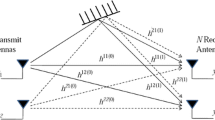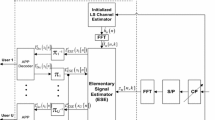Abstract
Rapid time-varying channel estimation is one of the biggest challenges in IEEE 802.11p standard. It is a wireless vehicular communication standard which is used for outdoor applications. This paper proposes a novel decision-directed recursive least squares time-domain channel estimation method that utilizes the guard interval of every orthogonal frequency division multiplexing symbol. Simulation results show considerably improved bit error rate performance with the proposed method that enables robust channel equalization in rapidly time-varying channel with high Doppler spread.







Similar content being viewed by others
References
Qu, F., Wang, F., & Yang, L. (2010). Intelligent transportation spaces: Vehicles, traffic, communications, and beyond. IEEE Communications Magazine, 48(11), 136–142.
Willke, T., Tientrakool, P., & Maxemchuk, N. (2009). A survey of intervehicle communication protocols and their applications. IEEE Communications Surveys and Tutorials, 11(2), 3–20.
Sengupa, R., et al. (2007). Cooperative collision warning systems: Concept definition and experimental implementation. Journal of Intelligent Transportation Systems, 11(3), 143–155.
Grau, G. P., et al. (2010). Characterisation of IEEE 802.11p radio channel for Vehicle-2-Vehiclecommunications using the CVIS platform, CAWS Tech. rep.
Cheng, L., et al. (July 2008). Highway and rural propagation channel modelling for vehicle-to-vehicle communications at 5.9 GHz. In IEEE International symposium on antennas and propagation and USNC/URSI national radio science meeting (APSURSI).
Cheng, L., et al. (2007). Mobile vehicle-to-vehicle narrow-band channel measurement and characterization of the 5.9 GHz dedicated short range communication (DSRC) frequency band. IEEE Journal on Selected Areas in Communications, 25(8), 1501–1516.
Bilstrup, K., et al. (Sep. 2008). Evalution of the IEEE 802.11p MACmethod for vehicle-to-vehicle communication. In Proceedings of the 68th IEEE Vehicular Technology Conference (VTC), pp. 1–5.
Paier, A. et al. (May 2010). Average downstream performance of measured IEEE 802.11p infrastructure-to-vehicle links. Proceedings of the IEEE ICC, pp. 1–5.
Xiao, P., et al. (2009). Time synchronization algorithms for IEEE 802.11 OFDM systems. IET international communication conference on wireless mobile and computing (CCWMC 2009), pp. 287–290.
Hamid, H. A., Tepe, K., & Raheem, E. A. (2007). Performance of DSRC systems using conventional channel estimation at high velocities. International Journal of Electronics and Communications (AEU), 61(8), 556–561.
Chang, M. X., & Hsieh, T. D. (2008). Detection of OFDM signals in fast varying channels with low-density pilot symbols. IEEE Transactions on Vehicular Technology, 57(7), 859–872.
Cho, W., et al. (May 2009). Performance evaluation of V2V/V2I communications: The effect of midamble insertion. In Proceeding of the Wireless VITAE, pp. 793–797.
Lin, C. S., et al. (Oct. 2009). Performance evaluations of channel estimations in IEEE 802.11p environments. IEEE international conference on ultra modern telecommunications (IUCMT), pp. 1–5.
Lin, C. S., et al. (2013). Performance evaluations of channel estimations in IEEE 802.11p environments. Telecommunication Systems, 52(4), 1731–1742.
Jiang, J., & Zhang, Y. (2014). A revisit to block and recursive least squares for parameter estimation. Computers and Electrical Engineering, 30(5), 403–416.
Manolakis, D. G., Ingle, V. K., & Kogan, S. M. (2000). Statistical and adaptive signal processing. New York: McGraw-Hill Int. Editions.
Moustakides, G. V. (Sep. 1996). Performance of the forgetting factor RLS during the transient phase. In Proceedings of the IEEE digital signal processing workshop, pp. 370–373.
Marum, G. A., & Ingram, M. A. (2007). Six time and frequency selective empirical channel models for vehicular wireless LANs. IEEE Vehicular Technology Magazine, 2(4), 4–11.
Zemen, T., et al. (2012). Iterative time-variant channel estimation for 802.11p using generalized discrete prolate spheroidal sequences. IEEE Transactions on Vehicular Technology, 61(3), 1222–1233.
Nuckelt, J., Schack, M., & Krner, T. (Sept. 2011). Performance evaluation of wiener filter designs for channel estimation in vehicular environments. In Proceedings of the vehicular technology conference, (pp. 1–5).
Sen, I., & Matolak, D. W. (2008). Vehicle–vehicle channel models for the 5-GHz band. IEEE Transactions on Intelligent Transportation Systems, 9(2), 235–245.
Author information
Authors and Affiliations
Corresponding author
Rights and permissions
About this article
Cite this article
Aggarwal, P., Gupta, A. & Bohara, V.A. Recursive Least Squares Channel Estimation for Rapidly Time-Varying Scenarios in IEEE 802.11p. Wireless Pers Commun 89, 227–240 (2016). https://doi.org/10.1007/s11277-016-3263-3
Published:
Issue Date:
DOI: https://doi.org/10.1007/s11277-016-3263-3




